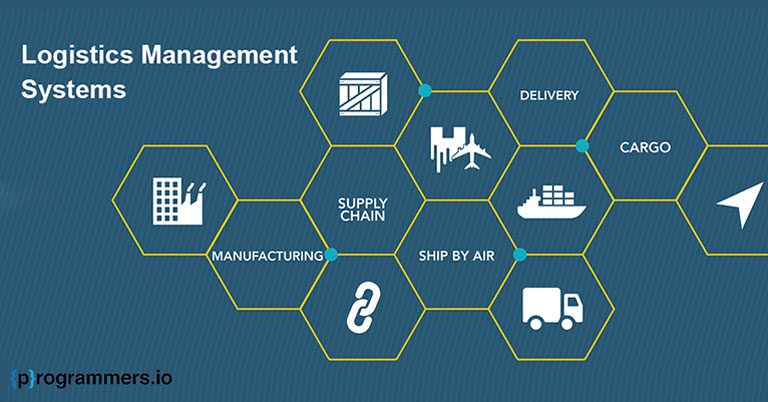Logistics management systems have been a major force behind the success of most organizations today. Pfizer rose to fame during the COVID-19 pandemic and became one of the biggest suppliers of sterile injections during the years 2020 and 2021. The increasing logistical prowess was achieved on the back of logistics management systems and other measures to improve supply chain and logistics.
Technology continues to be a major force of change in the field of logistics and supply chain. Reports from the market have revealed that the increasing use of IoT and emerging technologies means that several industries are moving towards the connected adoption of logistic systems.
In this article, we take a look at logistics management systems, the trends behind them and the growing challenges surrounding them.
What is Logistics Management?
Logistics can simply be defined as the flow of certain goods from one place to the other, i.e. transportation from the point of manufacturing to the point of consumption. The point of consumption usually includes retail outlets and customers.
A typical logistics management system includes the following processes:
- Both inbound and outbound methods of transport management.
- Fleet management
- Warehouse management.
- Inventory control.
- The processing of orders.
- Planning supply and demand.
- Managing interacting with other service providers.
Logistics management constitutes several functions such as the procurement of goods, the planning of delivery, the sourcing of transportation and the final dispatching. The process also involves unearthing the right means for delivery.
Considering the growing demands of supply chain across industries, logistics management has become extremely difficult for supply chain managers. Manual logistics management has become prone to a number of issues that result in delays in transportation and the delivery of goods. Customers are dissatisfied as a result of this change and have to put up with delayed deliveries and schedules.
Customer demand has shot up recently, as customers expect more transparency and equity within the delivery process. Logistic companies are on the search for ways to meet the high standards without incurring additional costs and expenditures.
What is a Logistics Management System?
A Logistics Management System or LMS is basically a software operation that refines the production standards and makes it easier for organizations to access information quickly. A logistics management system oversees all processes in the supply chain cycle from the delivery of raw materials to the manufacturing site and the shipment of finished goods to retail or end customers.
Logistics management systems rely on technology to provide greater functionality and scope to users. There are certain similarities between supply chain management software and a logistics management system. The tools and functionalities of a logistics management system can extend to the following areas:
- Processing all customer requests.
- Managing inventory.
- Processing purchase orders.
- Managing sales and distribution.
- Suppliers’ management.
Your logistics management system can help get rid of all previous errors and problems to give you a unified platform for tracking inventory and finding out whether you are meeting customer requests.
Reasons to Have a Logistics Software
There are several advantages of handing over your management process to a logistics application. These advantages include:
- Refined Transportation: A logistics management system can help improve transportation across the board. Transportation is a crucial part of logistics. Transportation usually incurs charges related to energy, labor, fuel, shipping fees, motorway tolls and much more. Logistics management software can make it easier to track transportation and find out the best plans for shipping.
- Faster Delivery: An effective system can help improve time to delivery and satisfy customers in the best manner possible. Customers are happier when they have such a system at their disposal.
- Minimize Human Errors: Logistics software can also help minimize human errors and give you a chance to ensure efficiency in your operations. Logistics managed manually can lead to multiple human errors.
Trends in Logistics Management
The demand for logistics management systems has peaked during the pandemic in 2020 and 2021. The onset of the pandemic has put the spotlight on supply chain and logistics, which is why it is necessary for organizations to follow the new trends to come out of the industry. These include:
Artificial Intelligence
Logistic companies are expected to use AI or artificial intelligence to gather data from supply chain processes and improve results. The end objective is to offer intelligent transportation based on budgeted planning, demand forecasting and route optimization. AI driven logistics can help save costs and provide real-time forecasts.
Cloud Computing
Cloud integrated logistics software is expected to reign supreme in the years to come. Cloud-based logistics allows for better accuracy and gives organizations the ability to manage systems and processes better. Companies can significantly cut down on missing deliveries and lost products.
Blockchain
2022 will also see the implementation of blockchain in the logistics management process. Blockchain will make it easier to verify, record and manage interactions between different stakeholders in the logistics process. Blockchain can also help improve credibility within the supply chain and digitize the creation of contracts and the storage of documents.
Going for a logistics management system is a necessity that organizations cannot shy away from today. Keeping the changing trends in mind, you need to follow this guide and make sure you don’t get left behind.




